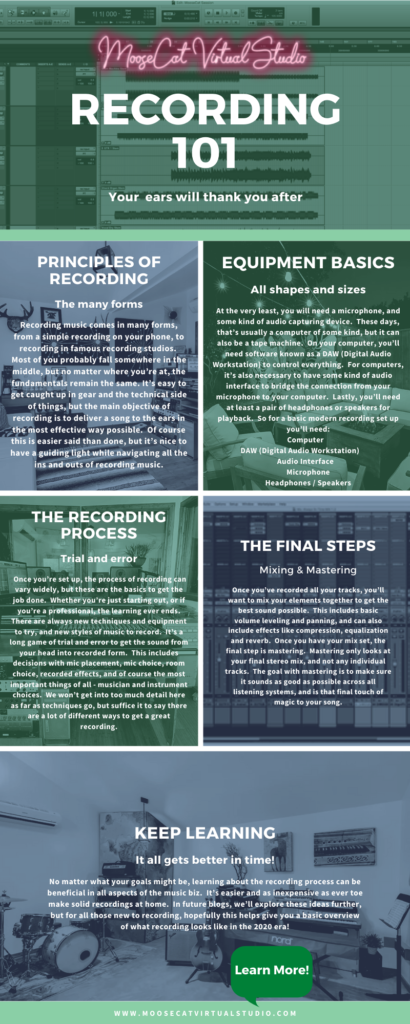Recording 101

So you wanna be a recording engineer huh? Or maybe you’re a musician who wants to record at home. No matter what your goals might be, learning about the recording process can be beneficial in all aspects of the music biz. It’s easier and as inexpensive as ever to learn how to make solid recordings. For the newbies out there, let’s talk about some of the basics when it comes to recording in the 2020’s.
Principles of Recording
Recording music comes in many forms, from a simple recording on your phone, to recording in famous recording studios. Most of you probably fall somewhere in the middle – but no matter where you’re at, the fundamentals remain the same. It’s easy to get caught up in gear and the technical side of things, but the main objective of recording a song is to deliver it to the ears in the most effective way possible. Of course this is easier said than done, but it’s nice to have a guiding light while navigating all the ins and outs of recording.
Equipment Basics
Recording rigs come in all shapes and sizes, but there are a few things that everyone will need to get the job done. At the very least, you will need a microphone, and some kind of audio capturing device. These days, that’s a computer, but it can also be a tape machine. On your computer, you’ll need software known as a DAW (Digital Audio Workstation) to control everything. For computer recording, it’s also necessary to have some kind of audio interface to bridge the connection from your microphone to your computer. Lastly, you’ll need at least a pair of headphones or speakers for playback. So for a basic modern recording set up you’ll need:
Computer
DAW (Digital Audio Workstation)
Audio Interface
Microphone
Headphones / Speakers
The Recording Process
Once you’re set up, the process of recording can vary widely, but these are the basics to get the job done. The learning almost never ends, whether you’re just starting out or if you’re a professional – there are always new techniques and equipment to try. It’s a long game of trial and error to get the sounds from your head into recorded form. This includes decisions with mic placement, mic choice, room choice, effects, and of course the most important thing of all – musician and instrument choices. We won’t get into too much detail here as far as techniques go, but suffice it to say there are a lot of different ways to get a great recording.
The Final Steps
Once you’ve recorded all your tracks, you’ll want to mix your elements together to get the best sound possible. This includes basic volume leveling and panning, and can also include effects like compression, equalization and reverb. Once you have your mix set, the final step is mastering. Mastering only looks at your stereo mix, and not any individual tracks. The goal with mastering is to make sure it sounds as good as possible across all listening systems, and is that final touch of magic to your song.
Hopefully this helps for all those new to recording! Check out our other blogs that go more in depth on these topics.

Really informative blog. Much thanks again. Want more. Harriett Ambrosi Alodie